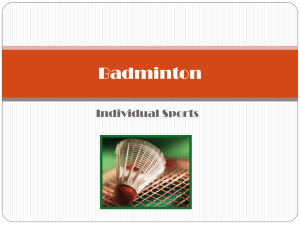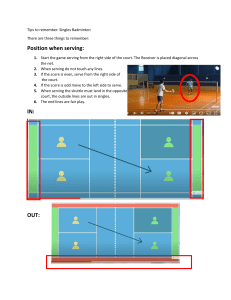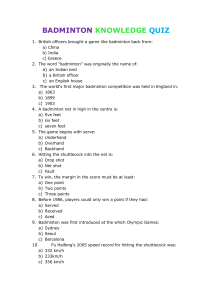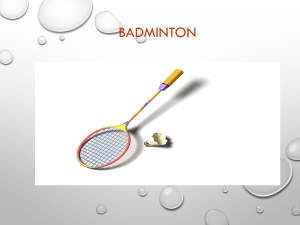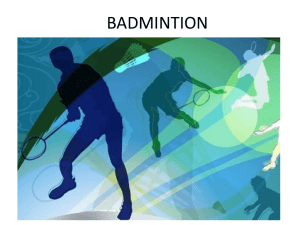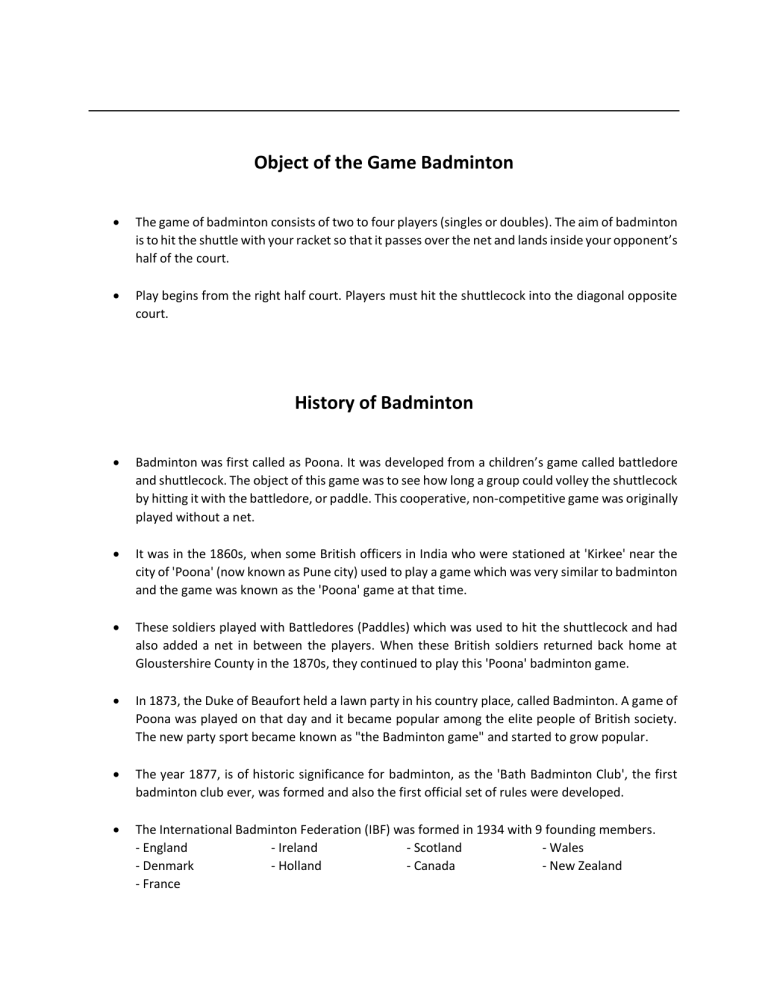
Object of the Game Badminton The game of badminton consists of two to four players (singles or doubles). The aim of badminton is to hit the shuttle with your racket so that it passes over the net and lands inside your opponent’s half of the court. Play begins from the right half court. Players must hit the shuttlecock into the diagonal opposite court. History of Badminton Badminton was first called as Poona. It was developed from a children’s game called battledore and shuttlecock. The object of this game was to see how long a group could volley the shuttlecock by hitting it with the battledore, or paddle. This cooperative, non-competitive game was originally played without a net. It was in the 1860s, when some British officers in India who were stationed at 'Kirkee' near the city of 'Poona' (now known as Pune city) used to play a game which was very similar to badminton and the game was known as the 'Poona' game at that time. These soldiers played with Battledores (Paddles) which was used to hit the shuttlecock and had also added a net in between the players. When these British soldiers returned back home at Gloustershire County in the 1870s, they continued to play this 'Poona' badminton game. In 1873, the Duke of Beaufort held a lawn party in his country place, called Badminton. A game of Poona was played on that day and it became popular among the elite people of British society. The new party sport became known as "the Badminton game" and started to grow popular. The year 1877, is of historic significance for badminton, as the 'Bath Badminton Club', the first badminton club ever, was formed and also the first official set of rules were developed. The International Badminton Federation (IBF) was formed in 1934 with 9 founding members. - England - Ireland - Scotland - Wales - Denmark - Holland - Canada - New Zealand - France Major international tournaments like the Thomas Cup which is for Men, and the Uber Cup which is for Women started to be held. Badminton was officially granted Olympic status in the 1992 Barcelona Games. From 9 founding members, IBF now have over 150 member countries. Facilities and Equipment of Badminton Racquet – used to hit the bird, the racquet is shaped like a tennis racquet and has strings, but weighs much less. The frame of the racket, including the handle, is not to exceed 680 mm (26.75 inches) in overall length, and 230 mm (9 inches) in overall width. The overall length of the head is not to exceed 290 mm. Most racquets are made from light man-made materials such as aluminum or graphite, and are strung with synthetic material such as nylon. Shuttle, Shuttlecock, Bird, Birdie – whatever it is called, it is badminton's version of a tennis ball. It has a small ball at the front to give it speed, and feathers protruding from it to help it float when it is hit high into the air. An official shuttlecock must have 14-16 feathers and are usually made from a goose or duck and from the left wing of the bird only. Shoes – special court shoes are worn to allow players to move quickly across the court, and to give them traction for quick movements around Net – plays an important role in badminton matches. The Badminton World Federation’s Laws of Badminton provide specific standards for net height, width, and construction. An official badminton net must measure 5 feet high in the center, and 5 feet, 1 inch at the sides. The net attaches to vertical posts on either side of the court. The net should measure 30 inches from bottom to top, and must consist of a uniform, dark colored mesh. The net should have a white tape running along the top to make the net’s full height visible to players and officials. *The net is 760mm in depth and a minimum of 6.1m wide. The top of the net from the surface of the court is 1.524m at the centre of the court and 1.55m over the side lines for doubles. There must be no gaps between the ends of the net and the posts.* Badminton Court – shall be a rectangle laid out with lines of 40mm wide, preferably in white or yellow color. The Badminton Court Dimensions are of 13.4m in length and 6.1m in width. Rules of the Game Scoring System Every time you win a rally, you get a point. The winner of a badminton match is the player(s) who win two games out of three. A game is won by being the first to reach 11, 15 or 21 points. Each game must be won by at least two points and a number of systems are available for extending a game where a score of 10-10, 14-14 or 20-20 has been reached. The server is not allowed to serve until his opponent is ready. If the opponent attempts to return service, he is deemed to have been ready. Both the server and the opponent receiving the serve are required to stand so that some part of both feet remains in contact with the surface of the court while in a stationary position until the service has been delivered. Every time there is a serve – there is a point scored. The side winning a rally adds a point to its score. At 20 all, the side which gains a 2 point lead first, wins that game. At 29 all, the side scoring the 30th point, wins that game. When you’re saying the score, always say the server’s score first. The side winning a game serves first in the next game If players commit an error in the service court, the error is corrected when the mistake is discovered. Serving – serving is how you start the rally Receiver – is the person who hits the second shot in the rally. In doubles, the receiver’s partner is not allowed to hit this shot. How to serve In badminton, the serve must be hit in an upwards direction, with an underarm hitting action. You are not allowed to play a "tennis style" serve. The main rule here is that when you hit the shuttle, it must be below your waist. To be exact, the rules define this to be a height level with the lowest part of your ribcage. In other words, you can serve from a bit higher than the top of your shorts, but not much. Service courts – the service courts are smaller box shapes inside the court. Two Service Courts – your right service court, and your left service court. Doubles Service Courts – they are wider, because they use the outside side line (remember: the doubles court is wider); and they are shorter, because they use the inside back line. How service courts are used The server must stand inside a service court. The receiver must stand inside the diagonally opposite service court. The serve must travel into the diagonally opposite service court. If the serve is going to land outside the service court, then the receiver should let it fall to the floor. If the receiver hits the serve, then the rally continues even if the serve had been going out. The server and receiver must stay inside their service boxes until the server contacts the shuttle with his racket. After that, they can leave the boxes immediately and move anywhere on court. Deciding who gets to serve first In a major tournament, a coin toss is used to decide which side will serve first. In more casual club or league games, you usually just throw the shuttle up in the air, let it land, and see which side it points towards: that side serves first. Position of Server and Receiver in Doubles Match In a doubles match between A & B against C & D. A & B won the toss and decided to serve. A to serve to C. A shall be the initial server while C shall be the initial receiver. Love All 1-0 1-1 2-1 2-2 3-2 3-3 Note: The order of server depends on the score odd or even same as in singles. The service courts are changed by the servicing side only when a point is scored. In all other cases, the players continue to stay in their respective service court from where they played previous rally. This shall guarantee alternate server. Singles, Doubles, and Mixed Doubles You can have either two or four players on a badminton court: one player on each side, or a team of two players on each side. Singles - One-against-one Doubles - two-against-two Five Types of Badminton Men’s singles Women’s singles Men’s doubles Women’s doubles Mixed doubles (each team is a man and a woman) *Men’s doubles and women’s doubles are also called level doubles.* Interval and Change of Ends When the leading score reaches 11 points, players have a 60 second interval. A 2 minute interval between each game is allowed. In the third game, players change ends when the leading score reaches 11 points. Terminologies Serve – the stroke used to put the shuttlecock into play at the start of each rally; also called a "service". Low serve – the low serve travels into the receiver's forecourt, to fall on or just behind his short service line. Low serves must travel as close to the net tape as possible, or they will be attacked fiercely. In doubles, the straight low serve is the most frequently used service variation. High serve – the high serve is hit very high, so that the shuttle falls vertically at the back of the receiver's service court. The high serve is never used in doubles, but is common in singles. Flick serve – although the flick serve is hit upwards, the trajectory is much shallower than the high serve. Drive serve – drive serves are hit flat to the back of the receiver's service court. Netshot – a netshot is played into the opponent's forecourt, as close to the net as possible. Drive – fast and low shot that makes a horizontal flight over the net. – a drive is played when the shuttle is near net height, at the side of the player's body. Push – a gentle shot played by pushing the shuttlecock with a little wrist motion. Lift – alift is played upwards to the back of the opponent's court. Midcourt lifts are most commonly played in response to a smash or well-placed push. Defensive lift – a lift that is hit very high, so that the player gains time for recovery to a good base position. Attacking lift – a lift that is hit more shallowly, so that the opponent is forced to move very quickly to prevent the shuttle from travelling behind him. Clear – clear travels high and to the back of the opponent's rear court. Defensive clear – a clear that is hit very high, so that the player gains time for recovery to a good base position. Attacking clear – a clear that is hit more shallowly, so that the opponent is forced to move very quickly to prevent the shuttle from travelling behind him Baseline – The back boundary line at each end of the court, parallel to the net. Carry – an illegal stroke in which the shuttle is not hit, but caught and held on the racket before being released; also called a drop shot Drop shot – a shot hit softly and with finesse to fall rapidly and close to the net in the opponent's court. Fault – a violation of the playing rules. Forehand – the stroke used to return a ball hit to the right of a right-handed player and to the left of a lefthanded player. Backhand – the stroke used to return balls hit to the left of a right handed player and to the right of a lefthanded player. Kill – fast downward shot that cannot be returned. Let – a minor violation of the rules allowing a rally to be replayed. Match – a series of games to determine a winner. Rally – the exchange of shots that decides each point. Service court – the area into which a service must be delivered. Different for singles and doubles. Short service line – the front line of the service courts 1.98 metres from the net. Singles: A game where one player plays against another player. Smash – smash is a powerful stroke or hard-hit overhead shot that forces the shuttle sharply downwards into the opponent's court. Wood shot – legal shot in which the shuttle hits the frame of the racket. 4 Facts about badminton that will absolutely blow your mind! 1. 2. 3. 4. The Asian domination of the sport A badminton match once lasted just 6 minutes A shuttle is made from the left wing of a goose India played its part in the discovery of the game History of Badminton The origins of the game of badminton date back at least 2,000 years to the game of battledore and shuttlecock played in ancient Greece, China, and India. 1. Badminton took its name from Badminton House in Gloucestershire, the ancestral home of the Duke of Beaufort, where the sport was played in the last century. The IBF was formed in 1934 The first big IBF tournament was the Thomas Cup in 1948 The Uber Cup in 1946 The World Cup invitational event started in 1981 and is organized by the International Management Group (IMG) The year 1996 was a landmark in USA badminton 2. In December 1995, the IBF introduced a new concept tournament in California, the Hong Ta Shan Cup, a men’s invitation tournament with the best players and big prize money. Originated or one called as “POONA” 3. Badminton game played on a rectangular court by two players or two pairs of players equipped with light rackets used to volley a shuttlecock over a high net that divides the court in half. Equipments 1. COURT The area of play, as defined by the outer boundary lines 20 ft. x 44 ft. whole court (doubles) 17 ft. x 44 ft. (singles) *6.10m x 13.40m dimension of the court *The dimensions of a badminton court are 20 ft x 44 ft (6.1 m x 13.4 m), an area of 880 ft2 (81.75 m2). The diagonal length of the full court is 48.30 ft (14.72 m)* 2. NET The net is made of fine cord, dark in color and of an even thickness, with a mesh. The net is 760mm in depth and a minimum of 6.1m wide. The top of the net from the surface of the court is 1.524m at the center of the court and 1.55 over the side lines for doubles. *1.55m x 1.524m dimension of badminton net 3. NET POSTS The posts are used to hold the net in place 4. RACKET The instrument used by players to hit the shuttlecock Rackets are fragile. Avoid striking the floor, wall, net, posts, or your partner. Also avoid flipping, throwing, or twirling rackets. Replacement costs will be assessed for damaged rackets. 5. SHUTTLECOCK Also known as bird or birdie It is a cork to which feathers are attached to form a cone shape, or a similar object of plastic, struck with rackets in the games of badminton and battledore. * weighs 5g Basic Skills 1. GRIP a. FOREHAND GRIP With the racket head perpendicular to the floor, shake hands with the grip so the “V” formed by the thumb and forefinger is on the top of the handle. b. BACKHAND GRIP Using a forehand grip, rotate the hand slightly so the thumb is along and parallel to the wide side of the handle. 2. FOOTWORK a. Move toward the shot with short steps and end with a long stride. b. Most shots are played with the body at right angles to the net. c. In the ready position the racket is held high, the knees are slightly bent, and the body weight is on the balls of the feet. 3. STROKES a. CLEAR A shot used to drive your opponent away from the net or forecourt or to slow the game. The bird should fly above the opponent’s reach and fall within one foot of the baseline. b. SMASH An attacking shot made at the limit of one’s upward reach and slightly in front of the shoulder. At the moment of contact, the arm and wrist come down forcibly. c. DRIVE A flat shot kept as low as possible and is second only to the smash as an attacking shot. d. DROP SHOT Any shot that drops immediately after crossing the net. The descent of the bird is controlled with little follow-through. e. NET SHOT Any shot played as near to the net as possible, controlled by wrist and forearm. The hairpin shot is an example of a net shot. 4. SERVE a. HIGH AND DEEP Take a position near and on the proper side of the center line and about four feet behind the short service line. Drop the bird on the racket side and swing the racket forward. b. LOW AND SHORT Take a position closer to the front service line. The racket is swung forward with little follow-through. c. DRIVE A quick snap of the wrist in the backhand grip with the bird held directly in front of the body. HAND SIGNALS Service judge 1. Foot Fault / Foot not Stationary The feet of both players must remain in a stationary position until the serve is made. The server’s feet cannot be touching the line at this time. The service judge will stretch out their right leg and signal a fault with their right hand because a player’s feet were off the ground or they were on the boundary line. - When serving, the server’s feet can’t touch any other lines of the court and both feet should be firmly on the ground and not in the air. The server and receiver both should stand diagonally opposite each other while at the time of service and receive and they cannot stand outside the bounds of the court lines. 2. Hitting the feathers first - Server fails to hit the bottom of the shuttlecock According to rule 9.1.4, a player’s racket face should hit the bottom of the shuttlecock. If a player fails to hit the bottom of the shuttlecock when serving. The service judge will open their right hand and lightly touch the palm with their left hand to indicate a service fault. 3. Shuttle Above the Waist The shuttle, at the instant of being hit is higher than the server’s waist (defined as his lowest rib) or the head of the racket is higher than the server’s racket hand. If the shuttle is too high when the serve is made, the service judge will place their right hand horizontally across their ribs. *below 1.15 metres from the surface of the court 4. Racket not Pointing Down - Racket handle should face up If the racket handle is facing up when the shuttlecock is hit the service judge will lift up their open hand with palm facing out to indicate a fault due to the racket handle facing up. Rule 9.1.6 states that when a serve is made the racket handle must be facing down at the moment the shuttlecock is hit. - if the racket's head is not pointing downwards at the moment of impact, the service judge will raise their right hand 5. Double Movement or Movement Interrupted - BWF rule 9.1.1 states “Neither side shall cause undue delay to the delivery of the service once the server and the receiver are ready for the service. “ After a player finishes raising their racket head backwards any delay is undue delay of serve. (Movement Interrupted) Also, rules 9.1.7 and 9.2 tell us that, once a player begins to swing his/her racket forward, the service is deemed to have begun and the racket must continue moving forward in a continuous motion until the serving action is completed, otherwise a fault will be called--for noncontinuous movement. (Double movement) The service judge will swing their right arm to the left to indicate that the player has been penalised. Line judge 6. Unsighted – the line judge can’t see the shuttlecock clearly (because their view is blocked by a player’s body or other unavoidable situation), as they were unable to see whether the shuttlecock landed in or out they should cover the eyes with their hands to let the umpire know. 7. Out – the shuttlecock lands outside the lines of the court If the shuttlecock lands out of bounds the line judge must loudly and quickly shout “Out” so that both players and spectators hear, and will stretch their arms out to the side level with each other while looking at the umpire with a fixed stare to ensure the umpire is clear about the decision. 8. In – the shuttlecock lands inside the line If the shuttlecock lands inside the line, no announcement is needed, the line judge will just point their right hand at the line. Badminton Individual Sport Each organization is allowed 1 singles and 1 doubles team. A student may compete in both. Rules A player must wait until his opponent is ready before serving. If the opponent attempts a return then he is ruled having been ready. The feet of both players must remain in a stationary position until the serve is made. Your feet can not be touching the line at this time. It is not a fault if you miss the shuttle while serving. The shuttle cannot be caught and slung with the racket. A player cannot hold his racket near the net to ward off a downward stroke by his opponent or to interfere with his racket. Faults The shuttle, at the instant of being hit is higher than the servers waist or the head of the racket is higher than the servers racket hand. The shuttle does not land in the correct service court. The server's feet are not in the service court or if the feet of the receiver are not in the court diagonally opposite the server. The server steps forward as he/she serves. Any player balking or feinting his opponent before serve or during serve. A serve or shot that lands outside the court boundaries, passes under or through the net, touches any other obstructions or a players body or clothing. The boundary and service lines are considered in play. The shuttle in play is struck before it crosses the net to the striker's side of the net. You may follow through over the net. A player touching the net or its supports with his body or racket while the shuttle is in play. Hitting the shuttle twice in succession by a player or team. Scoring System o o o o o o A match consists of the best of 3 games of 21 points. Every time there is a serve – there is a point scored. The side winning a rally adds a point to its score. At 20 all, the side which gains a 2 point lead first, wins that game. At 29 all, the side scoring the 30th point, wins that game. The side winning a game serves first in the next game. Interval and Change of Ends o o A 1 minute interval between each game is allowed. In the third game, players change ends when the leading score reaches 11 points. Singles At the beginning of the game (0-0) and when the server’s score is even, the server serves from the right service court. When the server’s score is odd, the server serves from the left service court. o If the server wins a rally, the server scores a point and then serves again from the alternate service court. o If the receiver wins a rally, the receiver scores a point and becomes the new server. They serve from the appropriate service court – left if their score is odd, and right if it is even. o Doubles A side has only one ‘set’. The service passes consecutively to the players as shown in the diagram. At the beginning of the game and when the score is even, the server serves from the right service court. When it is odd, the server serves from the left court. o If the serving side wins a rally, the serving side scores a point and the same server serves again from the alternate service court. o If the receiving side wins a rally, the receiving side scores a point. The receiving side becomes the new serving side. o o o o The players do not change their respective service courts until they win a point when their side is serving. If players commit an error in the service court, the error is corrected when the mistake is discovered. In a doubles match between A & B against C & D. A & B won the toss and decided to serve. A to serve to C. A shall be the initial server while C shall be the initial receiver. Course of action / Explanation Score Love All Service Court from Service Server & Receiver Win ner of the rally Right Service Court. A serves to C. A and A & Being the score of the C are the initial B serving side is even. server and receiver. A & B win a point. A & B will 1-0 change service courts. A serves again from Left service court. C & D will stay in the same service courts. C & D win a point and also right to 1-1 serve. Nobody will change their respective service courts. Left Service Court. Being A serves to D the score of the serving side is odd C & D Left Service Court. Being D serves to A the score of the serving side is odd. A & B A & B win a point and also right to 2-1 serve. Nobody will change their respective service courts. Right Service Court. B serves to C Being the score of the serving side is even C & D C & D win a point and also right to 2-2 serve. Nobody will change their respective service courts. Right Service Court. C serves to B Being the score of the serving side is even. C & D C & D win a point. C & D will 3-2 change service courts. C serves from Left service court. A & B will stay in the same service courts. A & B win a point and also right to 3-3 serve. Nobody will change their respective service courts. Left Service Court. Being C serves to A the score of the serving side is odd. A & B Left Service Court. Being A serves to C the score of the serving side is odd. A & B A & B win a point. A & B will 4-3 change service courts. A serves again from Right service court. C & D will stay in the same service courts. Right Service Court. A serves to D Being the score of the serving side is even. C & D Note that this means: o The order of server depends on the score odd or even same as in singles. o The service courts are changed by the servicing side only when a point is scored. In all other cases, the players continue to stay in their respective service court from where they played previous rally. This shall guarantee alternate server . SERVICE JUDGE
